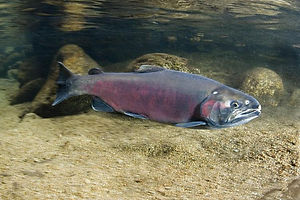Projects
6PPD-quinone and its impact on coho salmon
In December 2020, scientists at the University of Washington reported that they had finally been able to determine why there were high rates of coho salmon dying in the Puget Sounds area as they returned upstream to spawn. Although the researchers were initially tasked with analyzing 2,000 chemicals and compounds, after many trials the culprit was found to be from 6PPD which is a component used in the manufacture of tires to reduce the breakdown of rubber.
Ozone, a gas created when pollutants emitted by cars and other chemical sources react in the sunlight, breaks the bonds holding the tire together. 6PPD helps by reacting with ozone before it can react with the tire rubber, and thus sparing the tires. The problem occurs when 6PPD reacts with ozone which transforms into multiple chemicals, including 6PPD-quinone, the toxic chemical that was found to be responsible for killing the salmon.
Shortly after the report was out, Dr.Birgit Hagedorn, a chemist and AWC board member, became concerned about whether or not this could be a problem in Anchorage. The cost to analyze water for this compound is $500 per test. In consultation with AWC, it was decided to start a GoFundMe campaign to generate support for the project. Enough funding was raised to test 8 samples for 6PPD-quinone. High traffic areas in Anchorage were determined, and, in April, samples were gathered from Ship Creek by the Glenn Highway and Chester Creek at the New Seward Highway as well as the stormwater that drains into them at those locations.
There were positive detects in the stormwater that drains from the New Seward Highway into Chester Creek and levels were high enough to be concernable. Fortunately, the dilutions of the concentrations were still low in the creek itself. The compound was also detected in two storm drainages into Ship Creek. but the results were below the concernable level, and the compound was non-detectable in Ship Creek water itself. The analyses are only a few, however, and do not allow an in-depth understanding on how the compound affects the creeks. It would be good to continue to study local waterways that are adjacent to high-use traffic corridors.
If you should see fish die-offs that are out of the ordinary, please contact AWC or Sportfishing at the Alaska Department of Fish and Game at (907) 267-2218.
VIDEOS:
"Worn tires contribute to chemical that kills Coho salmon" 12-2-20
"Study of local creeks looks for toxic chemical that could be killing fish" 5-28-21
"Scientist samples Anchorage creeks for chemical that could be killing fish" 9-10-21


